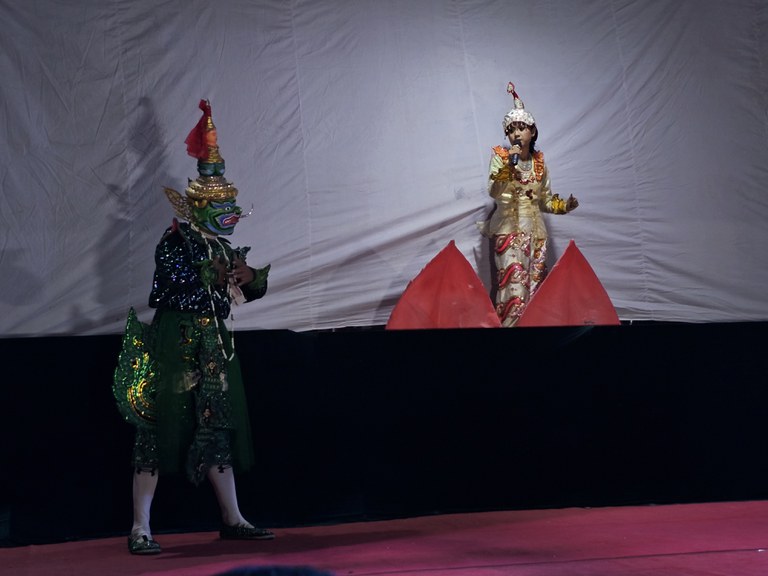For 145 years, the Myanmar city of Pyapon has marked the end of the rainy season with a performance of the ancient Indian epic poem Ramayana–never halting the annual ritual, even during Japanese occupation in World War II, a major uprising against harsh military rule and a catastrophic cyclone.
These days, however, the dancers who have for seven generations made the Ayeyarwady River delta region city famous for performances of the Burmese version of the Sanskrit epic fear they may be the last of their kind in a country plunged into economic hardship and political turmoil in the wake of the COVID-19 pandemic and a 2021 military coup.
“COVID health problems arise. Political crises arise. The days of performance are getting shorter,” said Zaw Oo, chairman of the Pyapon Ramayana troupe.
“Funds are scarce. Jobs are scarce. Moreover, foreign culture infiltrates. It is really hard to preserve it so it won’t disappear,” he told RFA Burmese.

The 53-year-old father of two is a national gold medalist in performing as Dathagiri, the ten-headed chief antagonist in the Ramayana epic poem and the subject of worship in both Hindu and Buddhist temples in India and across Southeast Asia.
“The main reason for performing is for safety,” Zaw Woo said of the belief that to keep Pyapon safe, the annual reading of the play must not be broken.
“If we cannot perform it, we have to serve meals for Dathagiri as a token offering every year,” he told RFA. “We have to perform it – even if it’s an hour or a verse – to keep the tradition.”
The Pyapon dance troupe has made modifications to tradition to keep people in seats for a lengthy poem that in the original Sanskrit has 24,000 verses.

Overseas tour
The Burmese version of the Ramayana used to require 45 days to perform, but the troupe trimmed it back – to nine days and nine nights.
During the pandemic and following the February 2021 military takeover, the dance became a one-day, closed-door performance at Pyapon’s Shwe Nat Gu Pagoda. Last year, they put on the Ramayana for one day at the Rama theater, but this year, it ran for three days at the end of November.
The truncated version of Myanmar’s national epic got mixed reviews, even from sympathetic fans.
“In the past, I liked watching it. Watching all nine episodes. Now it’s just one afternoon,” said a 65-year-old woman named Myint. “I’m just watching it to slake my desire.”
“Now, young people don’t dare to go out, so it’s not as crowded as it used to.” added Myint.
The Ramayana dates as far back as 7th to 4th centuries BCE in what is now northwestern India, and became a major cultural and moral influence on Hinduism and Buddhism. Versions of the story of Prince Rama are found across South Asia and Southeast Asia, from the Maldives to the Philippines.

She told RFA that fears of instability in Myanmar since the coup has taken away her enjoyment in going to the theater.
The Pyapon dancers – proud amateurs with day jobs – are hoping their fame in Myanmar can translate into international support for the struggling troupe.
In October they were invited to perform the Ramayana at the Indian embassy in Yangon, 75 miles (120 kilometers), which led to plans to put on the drama in India, Nepal and Indonesia, said Zaw Woo.
“While he was giving us certificates of honor, the Indian ambassador – together with diplomats from the Nepali and Indonesian embassies – promised that he would do everything possible to help our Pyapon Ramayana troupe to visit these countries to perform the drama,” he said.
Dancing trumps job
Passion for performing remains high in Pyapon, despite the gloom and doom.

“I may not have eaten a meal, but if I’m performing the drama, I’m satisfied,” said Wai Phyo Aung, who is playing the role of Lakshmana, younger brother of Rama and has been dancing in the Ramayana troupe for 15 of his 34 years. He is the first in his family to perform after becoming fascinated with Ramayana dancing as a schoolboy.
“I used to work for a company, and I lost my job again and again after performing nine nights,” he told RFA. “So, in order not to lose my next job, I became a taxi driver.”
Sein Myint, the 77-year-old father of Zaw Woo, winner of three gold medals in a long dancing career, urges people to help keep the Pyapon Ramayana troupe dancing.
“Some people think we are performing the drama because we are receiving payments,” he said.
“We’re not. We’re manual laborers. If anyone offers to help us, we’ll accept it at any time.”
Translated by Htin Aung Kyaw. Edited by Paul Eckert.



